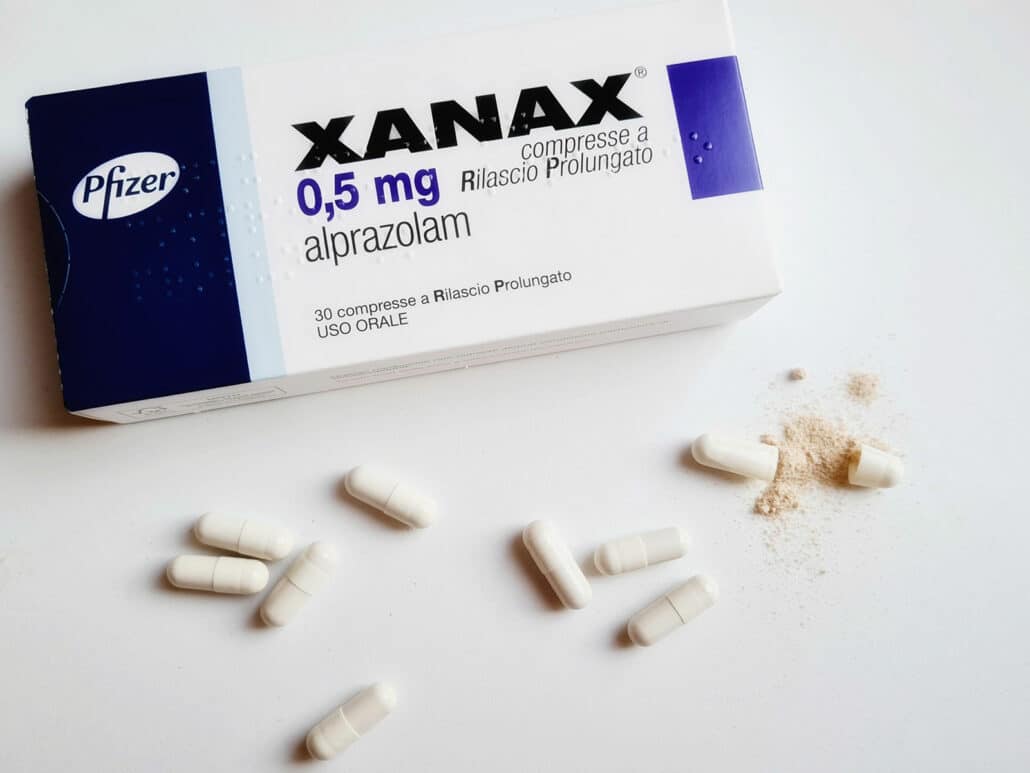Although Xanax bars are available by prescription for people who need anxiety medication, many people obtain them illegally. Some people purchase them from dealers who sell stolen or smuggled pills. Alternatively, some people have a friend or relative fill their own prescription and then buy it from them. Because Xanax is a controlled substance, its abuse potential is significant. Even those who use it as prescribed may become addicted and misuse it. People who have a prescription for it and use it for anxiety may misuse it by taking it too often or taking too high of a dose.

In 16% of the bodies of people who died from opioid overdoses in 2020, medical examiners found Xanax or other benzodiazepines present as well. Since the start of the pandemic, anxiety and mood disorder rates have increased significantly in New York and throughout the rest of the nation. In 2021, researchers found that generalized anxiety rates increased by about 45%. Also, psychological distress increased by 65%, and fear related to COVID-19 increased by about 60%.
Because of the higher rates of anxiety today, more people are being prescribed Xanax. Those who cannot or do not obtain it by getting a prescription are also looking for places to buy it, causing the street demand for it to increase. Both legal and illegal Xanax bars are often the reason why people wind up needing detox and drug rehab. This article will explain more about Xanax bars, how to identify signs of misuse, treatment options, the effects of Xanax addiction, and more.
Table of Contents
What Are Xanax Bars?
A Xanax bar is the pill form of Xanax, which is also known by the generic name alprazolam. People may also refer to Xanax bars as planks or zanies. Alprazolam is a benzodiazepine, which is a tranquilizer or depressant. It produces feelings of sedation and can help reduce anxiety, seizures, or muscle spasms. Another common benzodiazepine is Valium. Xanax bars are elongated tablets with four scored sections. They are scored so people can easily break them and take them in pieces for varying doses. Each Xanax bar contains 2 milligrams of alprazolam. Some people take half a pill by breaking the middle section, and others may take one-fourth.
How Do Xanax Bars Affect the Brain
To better understand how people become addicted to this medication, it helps to understand how it acts on the human brain. Xanax decreases the brain’s abnormal excitement levels. The active ingredient enhances the production of a brain chemical called gamma-aminobutyric acid, more commonly known as GABA. This chemical helps by stopping brain signals that normally cause excitement. When those brain signals work too much, a person feels anxious or panicked when there may not be a reason to feel that way.
With the right level of chemical correction, the brain can function normally and not leave a person feeling continually anxious or panicky. If a dose is too high, a person may feel too sleepy or relaxed. Since Xanax is very potent, using the correct dose is important. Also, that potency is what makes the drug risky when people develop an addiction to it. Another factor that makes it a higher addiction risk is that higher doses of it may trigger a reward response in the brain, and the brain causes people to seek more of those feelings.

How Does a Person Develop an Addiction To Xanax Bars?
It is important to understand that addiction is a disease. Addiction is considered a relapsing brain disease since it can cause permanent changes to the brain. Some of those changes in the brain can also be seen on imaging tests. When a person takes Xanax to relieve excessive anxiety, the person may develop a tolerance to that dose eventually. Doses tend to increase over time as that happens. Also, some people take more of the substance at times when they should not. For example, a person may take a double or triple dose of Xanax before a stressful test in college. Misusing the medication can lead to a substance use disorder (SUD). This is when someone misuses the drug by taking too much, taking it too often, or taking it without a medical need for it.
Substance use disorders can turn into addiction. In many cases, people who are misusing substances do not realize the potential harm or the present harm they cause. When a person realizes the harmful effects of an SUD and cannot stop taking the drug despite those problems, that is the definition of addiction. People who have an addiction to Xanax need addiction treatment services to overcome the addiction and return to a normal life.
What Are Treatments for Addiction To Xanax Bars?
Several treatment programs are available for people living in or near the Long Island area. Fortunately, marketplace insurance plans offer some coverage for necessary drug addiction treatment. These are some of the types of treatment programs that may be used to help people who are addicted to alprazolam.
Detox or MAT
Detox is the process of the body purging a substance naturally. If a person is misusing Xanax without a prescription and does not have a mood disorder, a detox program may include stopping the medication under medical supervision. Supervision is important since the brain craves to seek more of the substance are stronger. With medical supervision, people are less likely to relapse. Also, they have professional support. They may be prescribed medications to help ease unpleasant symptoms of withdrawal.
MAT is an acronym for medication-assisted treatment. When a person has anxiety or a medical need for a benzodiazepine, medical professionals may prescribe a different form of medication that is less addictive. A person may still go through a detox program that provides supportive care during the medication change.

Inpatient or Outpatient Rehab
There are several types of rehab programs. With inpatient programs, people stay in a facility 24/7 for a month or longer. These are better for people who can take an extended time away from work or family or have a long history of addiction. They are also ideal for people who live in unsupportive or risky environments. People who have a shorter history of addiction, have a supportive living environment, or have a lot of responsibilities may benefit from an outpatient care structure. There are several levels with varying lengths and frequencies of therapy sessions.
In therapy, people learn how to identify their addiction triggers or behavior causes. Also, they learn ways to deal with triggers, cope with trauma, and overcome addiction. When a person has a mood disorder, dual diagnosis treatment is often used. This is a special therapy approach that treats a mental health disorder and addiction at the same time. It is important since many mental health disorders are causes of people seeking substances or relapsing. Some facilities offer group therapy, individual therapy, family therapy, and supportive therapies. Yoga or other holistic therapies may focus on treating mind, body, and spirit to overcome addiction. In treatment, people learn how to communicate, repair relationships that are damaged by drug misuse, and develop healthier habits.
Signs of Xanax Addiction
The signs of Xanax addiction may vary some. However, most people display at least a few of some common behaviors. These are some examples:
- Changing jobs or friends often
- Loss of interest in hobbies
- Avoiding family and friends
- Lack of personal hygiene or care
- Excessive sleepiness
- Mood swings
- Eating less or more than usual
- Erratic sleeping patterns
- Missing work or school more often
- New financial or legal problems
- Strained relationships
- Empty pill bottles
- Closely guarding a drawer, purse or other place where Xanax is kept

Effects of Xanax Addiction
There are short-term and potential long-term effects of taking Xanax. A person who misuses the drug may notice dizziness, sleepiness, mood swings, or memory problems. Short-term effects may disappear after successful treatment if the person stays sober. However, the long-term effects of misusing the drug can be permanent or may last long. Some potential long-term effects are visual problems, difficulty processing information, slow responses, concentration problems, and memory problems.
Additional Information
Xanax, also known as Alprazolam, is a powerful medication approved by the FDA for the treatment of anxiety and panic disorders. However, misuse of Xanax, especially in high doses or without medical supervision, can lead to serious side effects and life-threatening conditions. It is a controlled substance classified as Schedule IV, indicating its potential for abuse and dependency.
Common Side Effects of Xanax
- Drowsiness
- Dizziness
- Dry mouth
- Constipation
- Changes in sex drive or ability
- Difficulty urinating
More serious side effects include hallucinations, suicidal thoughts, and jaundice. In cases of overdose, symptoms may include extreme drowsiness, confusion, impaired coordination, and loss of consciousness. Immediate medical attention is necessary in such scenarios.
Types and Colors of Xanax Bars
Xanax bars come in various forms and colors, including white, blue, and green. Each color represents different dosages and formulations, such as extended-release versions. Fake Xanax bars are also a concern, as they may contain harmful substances like fentanyl, which significantly increases the risk of overdose.
Withdrawal Symptoms and Management
Withdrawal from Xanax can be particularly challenging due to its sedative effects on the central nervous system. Common withdrawal symptoms include anxiety, insomnia, headaches, and muscle pain. Medical advice and supervision are crucial for safely managing withdrawal symptoms and preventing relapse.
Treatment Options for Xanax Abuse
Treatment for Xanax abuse typically involves a combination of medical detox, behavioral therapy, and support groups. Healthcare providers may use medications like methadone or buprenorphine to manage withdrawal symptoms and cravings. Inpatient and outpatient programs offer structured environments for recovery, focusing on both physical and psychological aspects of addiction.
Finding Help for Addiction To Xanax Bars
If you know someone who is misusing Xanax bars and may have an SUD or addiction, Long Island Interventions is here to help. In many cases, the first step is a meaningful intervention to help give the person a good incentive to seek treatment. We can help connect you with local resources for interventionists, inpatient drug treatment, outpatient drug treatment, dual diagnosis treatment, and more. Please contact us to learn more about available options for yourself or a loved one.
For more information and professional help, contact Long Island Interventions. Our treatment center provides comprehensive care for individuals struggling with Xanax abuse and addiction. Let us help you or your loved one on the path to recovery.
Please contact Long Island Interventions for information about Xanax Bar Addiction Treatment near you.
References
[1] https://nida.nih.gov/research-topics/opioids/benzodiazepines-opioids
[2] https://www.ncbi.nlm.nih.gov/pmc/articles/PMC8294026/
[3] https://www.dea.gov/sites/default/files/2020-06/Benzodiazepenes-2020_1.pdf
[4] https://medlineplus.gov/druginfo/meds/a684001.html
[5] https://medlineplus.gov/druguseandaddiction.html
[6] https://www.ncbi.nlm.nih.gov/pmc/articles/PMC5846112/

